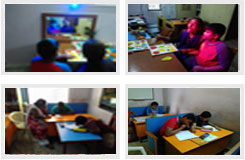The Institute has been constituted by a group of dedicated social workers, administrators, Specialists in the field of ENT, Ophthalmology, Orthopedic, Physiotherapy, Audiology & Speech therapy, Occupational therapy, eminent literary persons, Industrialists and parents of the special children. It is administered under a General Council and an Executive Council. The General Council of the Institute is the highest policy making body of the Institute functions under the president ship of an eminent writer & social worker. PROF. MOHAPATRA NILAMANI SAHOO. The Executive Council is headed by SRI PRADYUMNA KUMAR MISHRA, an educationist. SRI BHAGIRATHI PANDA, a qualified, experienced and dedicated worker in the field of rehabilitation of the handicapped, is functioning as Secretary of the Institute. At present the Institute is functioning at 293/A. Sahidnagar in a rented and fully equipped building.
The concept of Institute for Helping the Disabled, a novel venture, has found to be not only practical but also an ideal solution as well to counteract the misbelieves persisting in the society, achievement of early identification, referrals, motivating the de-motivated family members and last but not the least, the creation of awareness for peoples participation in prevention of multiple handicapped in the long run.


